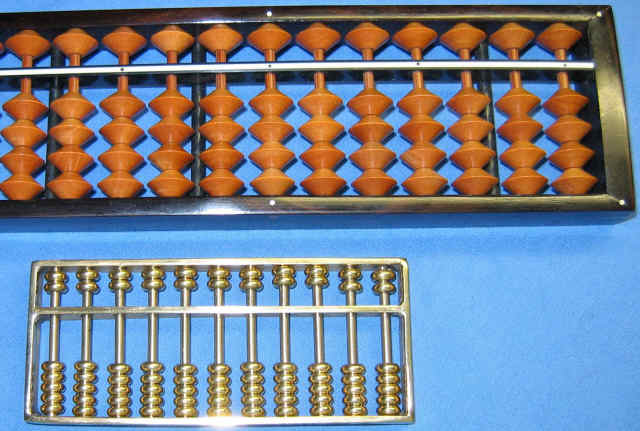

With this realization, we realize that 7 + 5 is obviously bigger than 10 so the number can’t be recorded on the ones string only. To use the Chinese abacus to add a number to 7, say the number 5, is easy as well.

Voila! You have suddenly recorded the number 7! Now you can do other things, and the number 7 will still be there in case you forget the number. If you want to record a number, say, the number 7, simply move one of the two beads on the ones string over to touch the divider, and then move two of the ones on the ones string over to touch the divider. If it is resting on either side away from it, it isn’t activated.

If a bead is positioned next to the central division or towards it, it means it is activated and has a value. If you are the US Treasury, you might want to start from millions and just round for smaller figures.įirst, move all the beads away from the central division. They do not actually have to start from ones.

Each rod has a decimal value: the first, ones the second, tens the third, hundreds and etc. The two strung beads each represent five and the five strung beads each represent one.
#ABACUS CHINESE FOOD HOW TO#
If you ever come into contact with an abacus, what do you do? You might want to learn how to use it. These suanpans can be used for doing division, multiplication and for taking square roots and cube roots as well if the user knows the techniques. Chinese can also use their abacuses for decimal computations. The Roman and Japanese versions are designed for base 10 computations. Chinese abacuses are designed to allow for hexadecimal computation. The Chinese kind has two beads on the rods on one side and 5 beads on the rods on the other side of the divider. There is a divider that separates the left and right strings of beads. The Chinese kind has beads strung on wires or thin wood rods. It was mentioned in a 2nd century BC Chinese document, and versions may have been used for thousands of years prior. The abacus is called “suanpan” (算盤, calculating pan) in China. The Chinese abacus has a long history, and using one is actually simple though it takes practice to use it proficiently. In fact, it isn’t clear where it was invented. Similar abacuses were used since ancient times in the Western world and India also. It wasn’t only the Chinese who used abacuses. I couldn’t figure out how they were used and felt kind of stupid because people were obviously calculating faster than I could. I remember when I first saw them, I was kind of dumbfounded. Up until calculators and teller machines became so cheap in China, they were widely used. In China, in outlying towns or more backward areas, you might see one lying around or actually used if you go into a shop. My only complaint about Abacus Inn is that after all these years they really haven't added anything new to the menu, or traditionally Chinese.The abacus is a calculating and numerical recording tool that was once widely used in East Asia. For something different off the dinner menu try the Ma Po Tofu (tofu with ground pork in a spicy sauce) or the spicy eggplant dish. If you have a group of more than a few people, try one of the dinner specials that comes with appetizers, soup, and several entrees. We'll occasionally eat dinner at Abacus Inn. They must have an awesome RO system in the back! The service is always speedy and friendly, and they've had the same staff for years (which to me says a lot about the restaurant and owners). Also, the ice water at Abacus Inn is super cold and fresh tasting. Lunch comes with soup, fried won tons, a huge egg roll, and fried rice/white rice, and hot tea. My favorites are the Abacus Special Chicken (fried chicken breast in a garlic sauce) and Sun Devil Chicken (chicken in a garlic jalapeno sauce). The lunch menu has your standard Chinese entrees. We typically hit up Abacus Inn for lunch on the weekends.


 0 kommentar(er)
0 kommentar(er)
